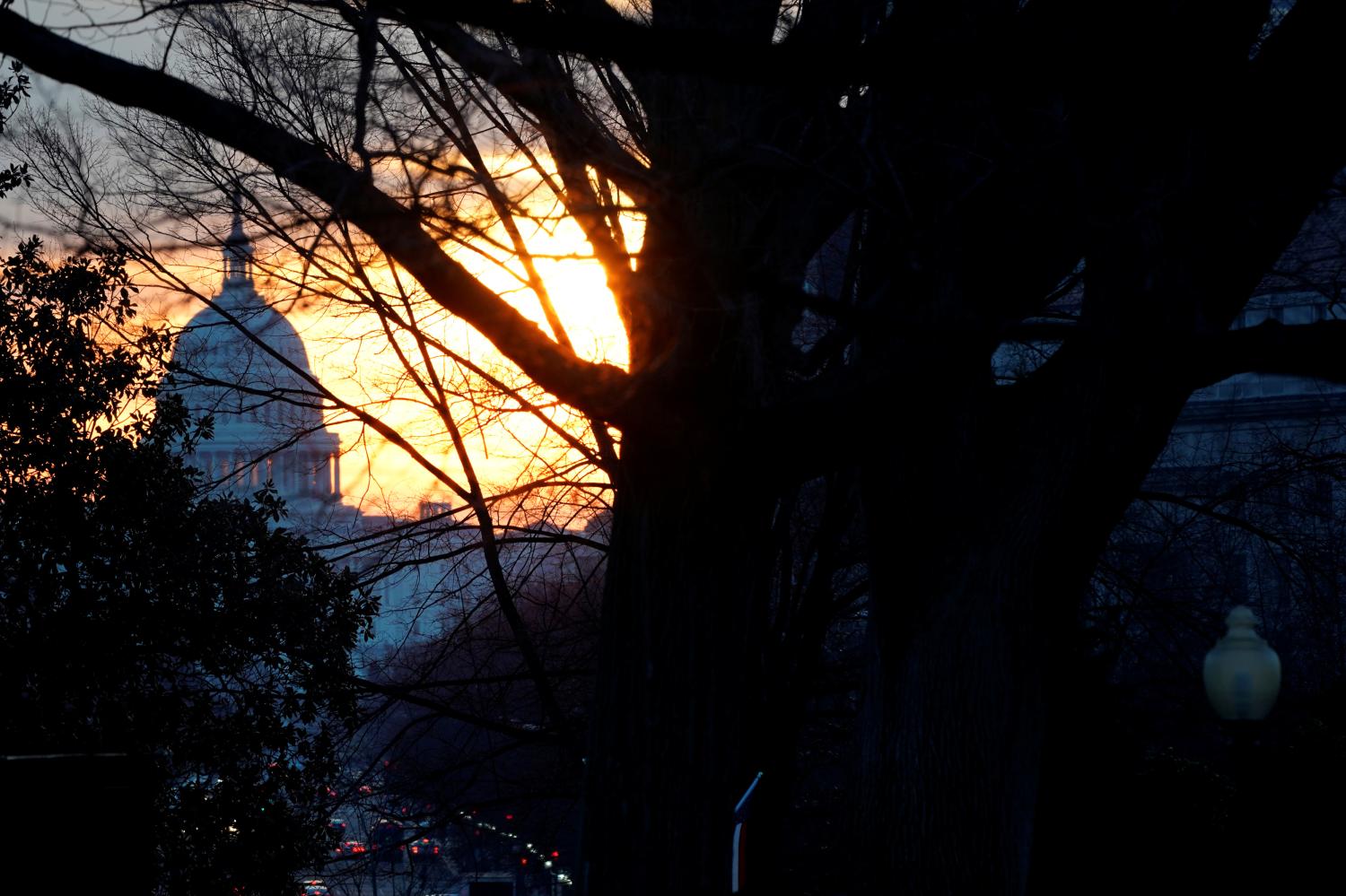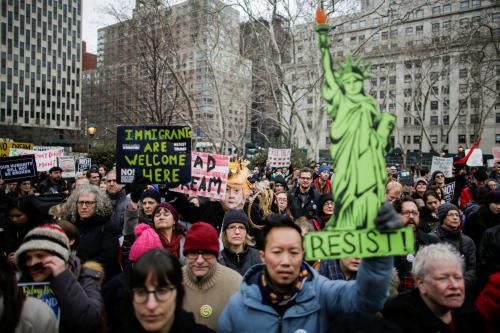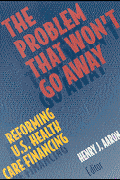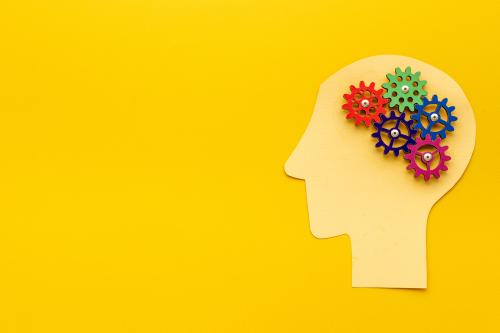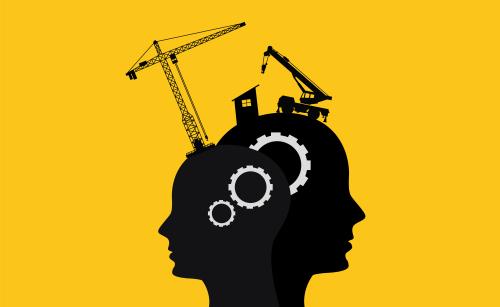This is the second in a five-part series of essays looking at whether the American project can survive. Read the rest of the essays here.
Americans are good problem solvers. Entrepreneurs and established companies, constantly seeking the support of customers and shareholders, do it to survive rapid changes in consumer tastes and technological change. Governments move more slowly, largely due to the checks and balances of the U.S. Constitution.
Nonetheless, some striking public policy successes over the past three decades have addressed some seemingly intractable problems: the dramatic decline in the rates of serious crime from the early 1990s until now, especially in New York City where the crime problem was once widely thought to be out of control; the remarkable improvement in air quality in many parts of the country (notably Los Angeles) that were once thought to be beyond rescue; and the successful global negotiation of the Montreal Protocol that substantially reduced the emissions of damaging substances that were rapidly depleting the ozone layer.
I also count as a success the multiple unconventional policies pursued by both the Bush and Obama administrations that kept the financial crisis of 2008 from turning into another Great Depression. However, the various rescue packages came at great political cost. Many voters perceived these steps as unfair, believing them to bail out Wall Street at the expense of Main Street, which gave rise to the conservative budget-pinching Tea Party and then to populist politicians and policy prescriptions of all stripes.
Political talk and posturing from populists and moderates alike is not likely to solve many of the difficult social and political challenges that now confront us. Unfortunately, our current politics also is not likely to save us. Given the deep political divisions in this country, neither party is likely to gain control of the presidency and win both congressional chambers with sufficient Senate seats and enough party unity to avoid filibusters, so that our current political leaders collectively are unlikely to take constructive steps to solve our major policy challenges.
Likewise, what bipartisan efforts have been mounted, such as those on immigration or shoring up the Affordable Care Act, have been sabotaged either by constantly moving targets set by the President, or by the implacable opposition of extremes in both parties, but principally by conservative republicans in the House, whom Speaker Ryan needs to keep his job.
This combination of forces implies the continuation of government dysfunction in Washington that, in part, explains voter frustration across the political spectrum. For reasons outlined in my initial essay, coupled with an emerging new force in the wake of the Parkland, Florida mass shooting tragedy—young people about to vote and their parents who may not only move the highly emotional topic of gun control off dead center, but could help fuel a backlash against politicians unwilling to act boldly on other issues—I am cautiously optimistic that the political climate will eventually generate new, more pragmatic leadership that will be more interested in problem-solving that constant political posturing.
In the meantime, for the reasons that follow, new major changes to meet our social challenges will be difficult to mount, except where bipartisan consensus exists in areas that unfortunately so far have moved us in the wrong direction.
It is hard to change a “new” status quo, though some change at the margin has proved possible (and undesirable)
What do civil rights, Medicare/Medicaid, environmental and workplace safety legislation, transportation deregulation, welfare reform, and multiple trade agreements have in common? They each had some measure of bipartisan support, which used to be viewed as essential for any major bill to become law.
Some believe bitter partisanship began with the controversial nomination of Judge Robert Bork to the Supreme Court in the late 1980s, which exposed an even deeper rift in Constitutional philosophy between the two parties than was already apparent. It has since evolved to the point where major legislation has been adopted by Congress largely, if not entirely, on partisan lines: the two tax cuts of 2001 and 2003 under President George W. Bush, the Affordable Care Act, and the Dodd-Frank financial reform law during the Obama administration.
Even single-party legislation, as both President Obama learned and President Trump is finding out, is more difficult to undo than each campaign on before becoming President. In each case, new rules and entitlements create new constituencies favoring continuation, at least in some form, of what was passed before.
One example is President Obama’s decision to continue the Bush era middle class tax cuts, though he and Congressional Democrats were able to raise rates for the highest earners. President Trump has had more success undermining the Affordable Care Act through a series of steps that are draining healthy customers of private insurance out of insurance pools, which could eventually lead to their demise, while allowing states to make it more difficult for Medicaid to cover health care costs for low income Americans. But still, amazingly enough, almost nine million people purchased private insurance under the ACA in 2018, not that many different than the year before.
Challenges with politically non-viable solutions—and one with no solution at all
Here are several additional examples of inaction on various important political issues, despite strong support for doing something.
First, one would think that Congress and the President could tackle the infrastructure crisis —crumbling bridges, crowded highways, and cybersecurity threats—whose severity is widely acknowledged across the political spectrum, and where bipartisan support probably exists even though a fix would require more deficit-financing (a good deal at the still historically low costs of borrowing).
But an infrastructure solution is likely to founder on the rocks of President Trump’s intransigence against letting the federal government pay any more than $200 million toward the solution, while some conservatives oppose spending even that. Democrats point out that cash-strapped states and localities don’t have the rest of the money, and not every infrastructure project can be financed by toll-based private financing.
In an ideal world with both parties willing to compromise, we would see $1 trillion-plus in shoring up our infrastructure, financed by some combination of congestion pricing on new roads, some increase in the gas tax, and some borrowing. Maybe one day something like will happen, hopefully before too many more insufficiently funded infrastructure-related disasters.
On the second issue, immigration, compromise between the two parties has been impossible since the last time Congress granted a retrospective path to citizenship during the Reagan presidency. Though the two parties have switched positions on immigration since, a bipartisan deal is potentially possible: tougher security measures (beyond those that have been taken in virtually every administration since the 1980s) along our southern border with Mexico paired with an immigration system that puts more emphasis on skills than on family ties, coupled with legal, renewable status for children of illegal immigrants under President Obama’s Deferred Action for Childhood Arrivals (DACA) Executive Order that President Trump rescinded. That would be a good deal for the country and the economy by adding skilled workers that would enhance innovation.
At this writing, however, the President shows no willingness to agree to any deal that doesn’t include something he calls a “Border Wall” and that doesn’t make dramatic cuts in the numbers of legal immigrants, which makes no economic sense if a reformed system giving preference to skilled immigrants were part of the deal. The result: continued stalemate.
A third issue on which I see no good political or substantive progress is the undue influence of money in politics, which distorts policy outcomes and is demeaning and time-consuming for elected officials to chase by “dialing for dollars.” Democrats especially have been highly critical of the Supreme Court’s 2010 decision in Citizens United v. Federal Elections Commission, which prevented the government, on First Amendment “free speech” grounds, from restricting independent corporate and union contributions to political action committees.
The Supreme Court has consistently held that the First Amendment allows political expenditures by anyone, and even a reversal of Citizens United (possible only in a very different Court) would only change the form but not the presence of money in political campaigns. That is because any future Supreme Court decision overturning Citizens United could easily be circumvented through increased individual contributions of corporate executives and shareholders as individuals.
While outright corruption already is banned, the problem of legally raised money in politics is one that our democracy must live with because it is protected by the Constitution, though in an ideal world, contribution limits should be raised to ease politicians’ fund-raising efforts. Fortunately, not all big money thinks alike. There are rich Democrats and rich Republicans. Some politicians will continue to make an issue of where their opponents’ money is coming from, and this strategy may sometimes have some success. But other factors, especially the social and cultural issues that have come to define our different political “tribes” and the impact that economic events are having on voters, will continue to play the dominant roles in election outcomes regardless of who’s paying for the campaigns.
Backtracking on trade and the deficit: The exceptions
There are two major policy areas—reversal of trade liberalization and the worsening of the federal budget deficit—where gridlock is not as evident. The first is bipartisan in nature, while the second is solely partisan. Both are moving in the wrong direction.
Excessive openness to trade is one subject where populism on both the right and left already seems to have converged, although President Trump seems to want more and faster trade restrictions than both his Democratic opponents and many in the Republican party.
The Commerce Department has recommended higher tariffs and aluminum on national security grounds, while the President has already added duties to solar panels—measures that have some Democratic backing. Yet all of these actions would penalize downstream U.S. companies in export markets, and U.S. consumers through higher prices, even more so if affected countries retaliate against our exports, as the EU is already contemplating.
The new “America First” trade policy, which admittedly is not as protectionist as candidate Trump sounded on the campaign trail, may turn out to be the “America Only” trade policy. What country in the future will want to make a deal with us, knowing that it could be abrogated by this or a future president? Eventually, cooler heads in both parties will realize this and will work to restore trust abroad in America by our allies and even our “frenemies” (China, but probably not Russia).
Keeping our economy open to foreign, investment and ideas is good for innovation and consumers, though it would be politically easier if Congress and the president adopted a serious plan to assist all with the lifetime training that continued technological change will require. I examine the details of how one might do that in a forthcoming essay.
As for federal deficits, Republicans alone made them worse by enacting the 2017 corporate tax bill, and then both parties added to the problem in the recent two-year spending package avoiding yet another government shutdown. These steps run counter to multiple failed official and commission-led efforts during the Obama years to bring down annual deficits to the rate of projected GDP growth, or roughly 3 percent, to keep the debt-to-GDP ratio roughly constant.
The ultimate problem with deficit reduction is that it has no real political constituency apart from policy wonks (not even Republicans, it turns out, who gladly voted for the deficit-enhancing 2017 tax cut). One reason why was explained by my long-time Brookings’s colleague and mentor, the late Charles Schultze, who famously analogized large and growing deficits to “termites in the woodwork,” which dampen investment due to higher interest rates and, consequently, reduce long-term economic growth. Compared to the prospect of raising taxes or reducing programs, most current politicians would prefer to let the termites eat away.
Ultimately, it will take a new generation of pragmatic, thoughtful leaders in both parties who both recognize the unsustainability of continued borrowing and the economic political and economic benefits of being better integrated with the rest of the world. This is not sheer fantasy. Already there are signs within the Republican party that thoughtful leaders thinking this way may emerge to challenge the President in the 2020 primaries. And not all Democrats are fire-breathing populists who have become a major force within that party.
As I suggested in my first essay, there is a large body of moderates in the middle of the political spectrum who are not well represented by growing extremism in either party, opening the way potentially for a third party, or a major reform of one of the parties that goes down to defeat in 2020 based largely on a populist platform.
Next up: The U.S. economy is basically sound, though not without significant challenges.

